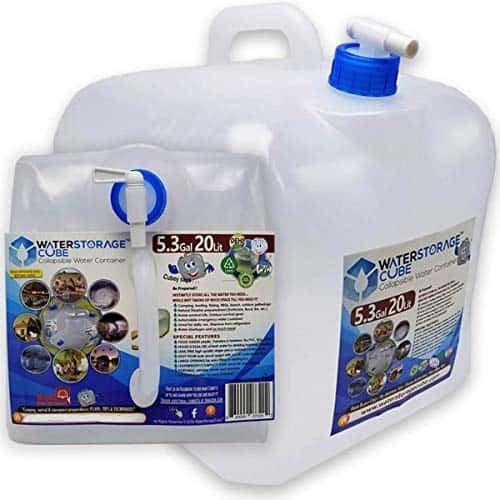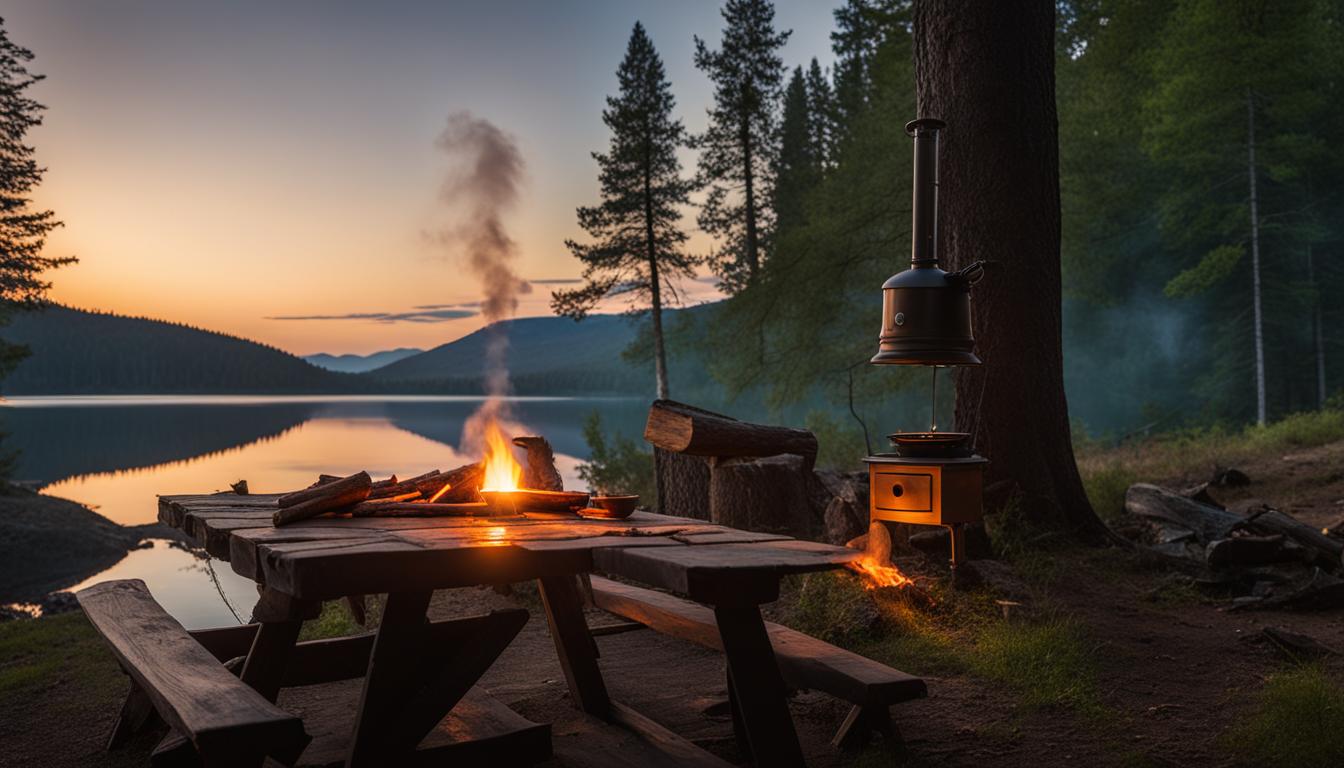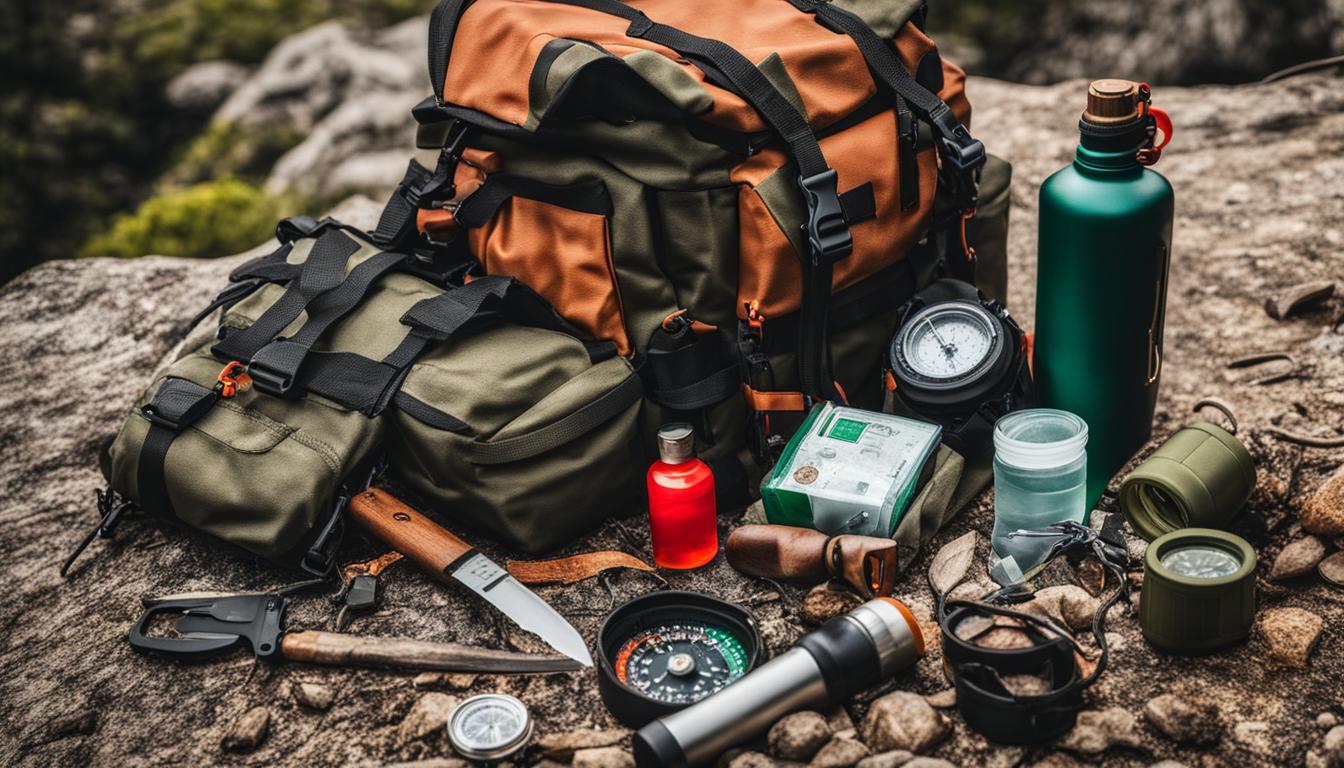Are you prepared to begin a memorable adventure in the great outdoors? Whether you’re an experienced explorer or just beginning your wilderness journey, mastering outdoor survival skills is crucial for a safe and enriching experience. In this all-encompassing guide, we will provide you with the information, tips, and techniques necessary to excel in the wilderness and emerge as a confident survivor.
From navigating the vast wilderness to building a reliable shelter, starting a fire, ensuring clean water, and signaling for help, this guide covers everything you need to know to conquer any survival situation. We’ll also delve into additional skills, recommended equipment, and the importance of preparedness and training. So, let’s dive in and unlock the secrets of outdoor survival together!
Key Takeaways:
- Developing outdoor survival skills is crucial for a safe and fulfilling experience in the wilderness.
- Navigating, building a shelter, starting a fire, and purifying water are essential survival techniques.
- Having the right equipment and being mentally prepared are key to wilderness survival.
- Continual learning and skill development through reading and training are highly recommended.
- Stay prepared, stay informed, and stay safe in the great outdoors!
The Best Survival Books for Outdoor Enthusiasts
When it comes to mastering outdoor survival, knowledge is key. The right survival books can provide valuable insights, tips, and techniques that can enhance your skills and help you thrive in the wilderness. To help you find the most reliable and practical resources, we have compiled a list of the best survival books written by reputable authors. These books cover a wide range of topics, from essential wilderness skills to long-term survival strategies.
Whether you are a seasoned outdoor enthusiast or a beginner looking to expand your knowledge, these books are highly recommended for anyone interested in enhancing their survival skills. They are filled with valuable information that can help you navigate through various survival scenarios and prepare you for the challenges of the wilderness.
“Survival can be summed up in three words – never give up. That’s the heart of it really. Just keep trying.” – Bear Grylls
Table: Recommended Survival Books for Outdoor Enthusiasts
| Book Title | Author | Description |
|---|---|---|
| The SAS Survival Handbook | John ‘Lofty’ Wiseman | A comprehensive guide to survival techniques, covering everything from basic first aid to building shelters and finding food in the wilderness. |
| Bushcraft 101 | Dave Canterbury | An essential guide for beginners, teaching fundamental wilderness skills such as fire-making, shelter-building, and navigation. |
| 98.6 Degrees: The Art of Keeping Your Ass Alive | Cody Lundin | A practical guide to surviving in extreme conditions, emphasizing the importance of maintaining core body temperature and improvising with limited resources. |
| The Outdoor Survival Handbook | Raymond Mears | A comprehensive manual that covers a wide range of survival skills, including foraging for food, constructing shelters, and navigating without a compass. |
| Wilderness Survival | Greg Davenport | A practical guide that focuses on the psychological aspects of survival, providing insights into decision-making, coping with stress, and maintaining a positive mindset. |
These recommended survival books are not only informative but also engaging, making them suitable for both educational purposes and leisure reading. With the valuable knowledge shared within their pages, you can enhance your outdoor survival skills and gain the confidence needed to face any wilderness challenge. Happy reading and safe adventures!
Mastering Fire-Making for Outdoor Survival
When it comes to outdoor survival, fire-making is a skill that should be at the top of your list. A fire provides warmth, light, a means to cook food, and a way to signal for help. In this section, we will guide you through the process of mastering fire-making in the wilderness.
Building a fire starts with selecting a suitable location. Look for a spot that is away from flammable materials and has good ventilation. Clear the area of any debris and create a fire ring or pit using rocks to contain the flames.
Next, gather firewood. You’ll need different sizes of wood, from tinder (small and dry) to kindling (slightly larger) and fuelwood (thicker and longer-lasting). Make sure to collect wood from dead and dry sources, as green or damp wood will be harder to ignite.
“Fire is nature’s television. It provides both warmth and entertainment.”
Now it’s time to start the fire. There are several techniques you can use, depending on the resources you have available. Using a lighter or matches is the simplest method, while flint and steel or friction-based methods like the bow drill require more practice and skill.
Remember to always practice fire safety. Keep a safe distance from the flames, never leave the fire unattended, and fully extinguish it before leaving the area. By mastering fire-making techniques and following proper safety precautions, you can ensure a reliable source of warmth, light, and sustenance in the wilderness.
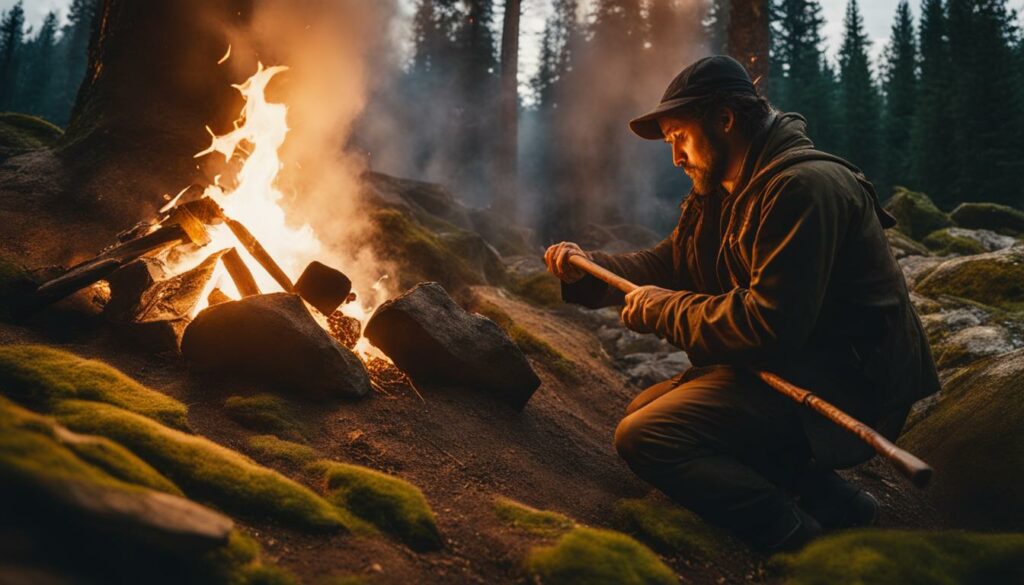
Fire-Making Techniques
| Technique | Pros | Cons |
|---|---|---|
| Lighter or Matches | Quick and easy to use. | Dependent on having a lighter or matches. |
| Flint and Steel | Produces a spark even in wet conditions. | Requires practice to master the technique. |
| Bow Drill | Can be done with readily available materials. | Requires physical strength and practice to master. |
| Hand Drill | Simpler version of the bow drill. | Requires more physical effort and skill. |
Each fire-making technique has its advantages and disadvantages. Consider practicing multiple methods to expand your skillset and ensure you can start a fire in various situations. Remember, fire-making is a skill that requires practice, patience, and respect for the power of fire.
Building Shelter for Wilderness Survival
When it comes to surviving in the wilderness, having a reliable shelter is crucial. In this section, we will discuss the skills and techniques necessary for building a shelter using natural materials. Whether you find yourself in an emergency situation or need a temporary shelter during your outdoor adventures, these methods can provide you with the protection and comfort you need.
Building a wilderness shelter begins with selecting a suitable location. Look for an area that offers natural protection, such as a grove of trees or the side of a hill. Once you have found a suitable spot, gather sturdy branches and use them to form a framework for your shelter. Thatching the roof with foliage such as leaves, grass, or branches will provide insulation and protection from the elements.
It’s important to have the right tools for shelter-building. A hatchet, knife, or multi-tool can be invaluable in gathering materials and constructing a sturdy shelter. However, if you don’t have access to these tools, improvisation is key. Look for rocks or other natural objects that can serve as tools. Remember, your safety is the top priority, so be cautious when using improvised tools.
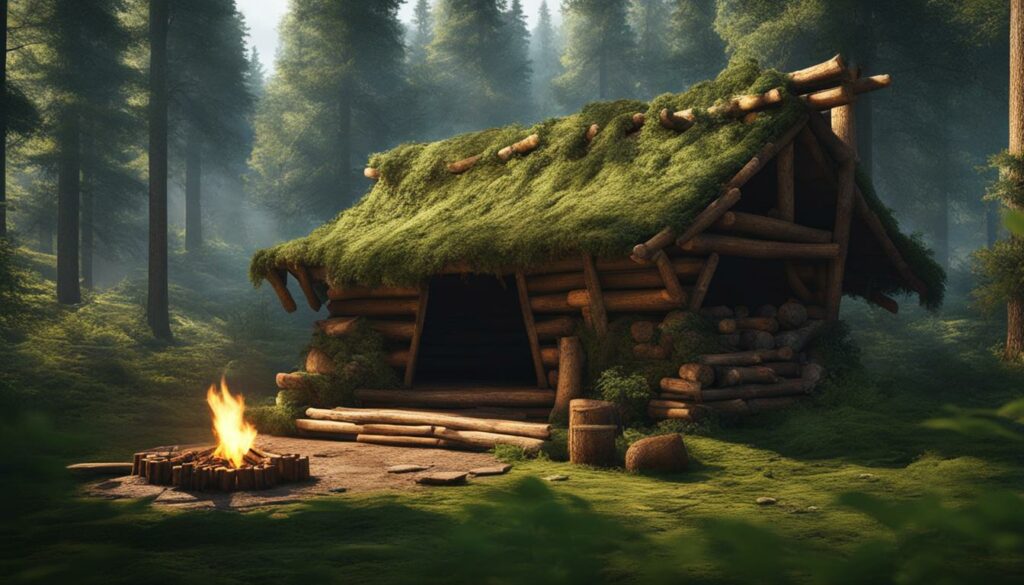
Table: Comparison of Different Wilderness Shelter Types
| Shelter Type | Materials | Pros | Cons |
|---|---|---|---|
| Debris Hut | Branches, foliage, leaves | Good insulation, easy to camouflage | Time-consuming to build |
| Lean-to | Branches, logs, tarp | Quick and easy to construct | Exposed to wind and rain on one side |
| A-frame | Poles, tarp, foliage | Sturdy construction, good protection from elements | Requires more materials |
Remember, building a wilderness shelter is not just about physical construction. It’s also about understanding the natural environment and utilizing resources wisely. Take into account factors such as wind direction, potential hazards, and the availability of materials. By combining knowledge, skills, and the right tools, you can create a safe and effective shelter in the wilderness.
Ensuring Clean Water for Outdoor Survival
When it comes to outdoor survival, access to clean drinking water is absolutely essential. In the wilderness, water sources can be unreliable and potentially contaminated. That’s why it’s crucial to know how to obtain and purify water to ensure your hydration and overall well-being.
There are several methods for water purification in the wilderness. One of the most common and effective methods is boiling. Boiling water for at least one minute will kill most types of pathogens, making the water safe to drink. It’s important to remember that boiling water will not remove chemical pollutants, so it’s still necessary to exercise caution and avoid water sources that may be contaminated.
Another method of water purification is filtration. This involves using a water filter or purifier to remove impurities and bacteria from the water. Portable water filters are designed specifically for outdoor use and can provide a reliable source of clean drinking water. It’s important to choose a filter that is suitable for your needs and the specific conditions of the wilderness you’ll be exploring.
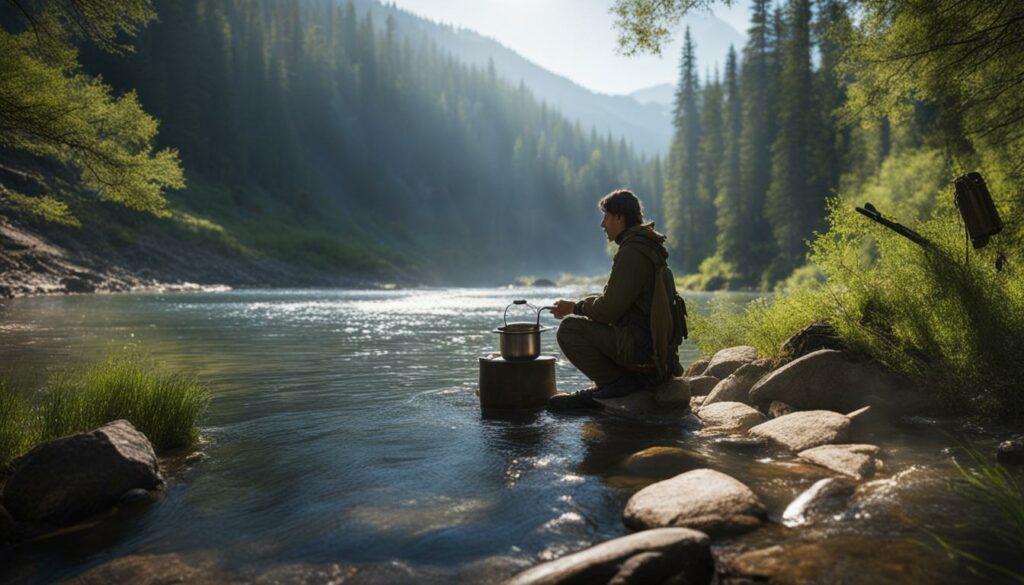
Additionally, if you don’t have access to a water filter or fire to boil water, there are alternative methods for water collection and purification. For example, you can collect rainwater by using a tarp or waterproof container. You can also extract water from plants through various techniques such as transpiration bags or solar stills. These methods may require additional knowledge and resources, but they can be effective in emergency situations.
Remember, water safety is of utmost importance in outdoor survival. Always prioritize finding and purifying water before consuming it, and be cautious of potential contaminants. By knowing and practicing these essential water purification techniques, you can ensure a safe and reliable source of drinking water in any outdoor survival scenario.
Navigating the Wilderness with Confidence
When venturing into the wilderness, having the ability to navigate your surroundings is essential for your safety and survival. Proper navigation skills can help you find your way back to civilization, avoid hazardous terrain, and locate important resources. In this section, we will explore various techniques and tools that will enable you to navigate the wilderness with confidence.
Navigation Tools
Carrying the right navigation tools is crucial when exploring unfamiliar territory. One of the most basic and essential tools is a map. A reliable topographic map of the area you plan to explore will provide valuable information on elevation, landmarks, and trails. It is important to familiarize yourself with the map’s symbols and legends to interpret the information accurately.
Another vital tool is a compass, which allows you to determine your direction and orientate yourself with respect to the map. Learning how to use a compass will enable you to take accurate bearings, follow specific routes, and navigate through challenging terrain. Remember to keep your compass away from magnetic objects, as they can interfere with its accuracy.
Celestial Navigation
In situations where you don’t have access to a map or compass, celestial navigation can be a valuable skill. By using astronomical objects like the North Star or the sun, moon, and stars, you can determine your direction and navigate with reasonable accuracy. Understanding the basics of celestial navigation can be a helpful backup when facing unexpected circumstances in the wilderness.
Remember that navigation skills require practice and experience. Before embarking on challenging wilderness expeditions, it is advisable to practice your navigation skills in familiar areas or take a navigation course. By honing your navigation abilities, you can explore the wilderness with confidence, knowing that you have the skills to find your way no matter the situation.

| Navigation Technique | Advantages | Disadvantages |
|---|---|---|
| Map and Compass | Provides detailed information, reliable in all conditions | Requires knowledge and practice, may be less accurate in dense forest or mountainous terrain |
| Celestial Navigation | Can be used when other tools are unavailable, does not require external equipment | Relies on clear visibility of celestial objects, requires knowledge of celestial navigation techniques |
| Dead Reckoning | Useful when no landmarks or tools are available, can estimate distance and direction | Relies on accurate pace counting and consistent navigation, may be less accurate over long distances |
| GPS Navigation | Provides precise location information, easy to use | Dependent on battery life and satellite reception, may not work in remote areas or during technical failures |
Signaling for Help in Emergency Situations
In emergency situations, being able to signal for help can significantly increase your chances of rescue. When you find yourself in a survival situation in the wilderness, it is crucial to have effective signaling techniques and reliable signaling devices. By mastering the skills and utilizing the right tools, you can alert rescuers to your presence and expedite your rescue in critical situations.
Signaling Techniques
There are various signaling techniques that can help you attract attention and communicate your need for help. One of the most effective techniques is using visual signals. This can include creating a smoke signal by starting a fire and creating a thick, dark smoke. You can also use reflective objects like mirrors or metallic surfaces to flash sunlight or moonlight towards potential rescuers. Another common visual signal is the use of brightly colored clothing or materials that stand out in the wilderness.
Another important signaling technique is using audible signals. Carrying a whistle can be extremely helpful in attracting attention, as the sound can travel long distances. By blowing a whistle in short bursts or patterns, you can create a distinct sound that is easily recognizable as a call for help. Additionally, shouting or yelling loudly can also help in attracting attention, especially if there are others nearby who may be able to hear your call.
Signaling Devices
Carrying signaling devices can greatly increase your chances of being spotted and rescued in an emergency. Some essential signaling devices include whistles, mirrors, and flashlights. Whistles are lightweight, easy to use, and can produce a loud sound that carries over long distances. Mirrors, particularly those designed for signaling purposes, can reflect sunlight or other light sources towards potential rescuers. Flashlights with a strong beam can be used to create Morse code signals by flashing the light in a specific pattern. These signaling devices should be kept easily accessible in your survival kit or attached to your clothing for quick and convenient use.
| Signaling Technique | Advantages | Disadvantages |
|---|---|---|
| Smoke Signal | – Can be visible over long distances – Can indicate your location |
– Requires a source of fire – Not effective in heavy rain or windy conditions |
| Whistle | – Produces a loud sound – Carries over long distances |
– Can attract the attention of predators – Limited to audible signals |
| Mirror | – Reflects sunlight or other light sources – Can be seen from afar |
– Requires sunlight or a light source – Limited to daytime use |
| Flashlight | – Can create Morse code signals – Can be seen at night or in low light conditions |
– Requires batteries or a power source – Limited to night-time or low light conditions |
By familiarizing yourself with these signaling techniques and carrying the right signaling devices, you can significantly increase your chances of being found and rescued in an emergency. Remember, it is important to stay calm, conserving your energy and resources while waiting for help to arrive. Signaling for help is a crucial step in your survival strategy, and it can make a lifesaving difference when you need it the most.

Additional Skills for Wilderness Survival
While mastering the essential survival skills covered in previous sections is crucial for wilderness survival, there are additional skills that can further improve your chances of staying alive. These skills include hunting, foraging, and food gathering.
Hunting: Hunting is a skill that requires practice, knowledge, and respect for wildlife. Understanding local hunting regulations and ethical practices is essential. Hunting provides an opportunity to acquire protein-rich food sources such as game animals and birds. However, it is important to note that hunting may not always be a viable option, depending on the situation and location.
Foraging: Foraging involves identifying and gathering edible plants and fungi in the wild. This skill requires knowledge of local flora, as well as the ability to differentiate between edible and toxic species. Researching and familiarizing yourself with edible plants in the area you’ll be exploring is crucial. Keep in mind that foraging should be done responsibly and sustainably to preserve the environment.
Food Gathering: In addition to hunting and foraging, there are various other methods of gathering food in the wilderness. This can include fishing, trapping, and snaring. Fishing requires knowledge of local water sources and fishing techniques. Trapping and snaring involve setting up mechanisms to catch small game. It is essential to learn these skills properly and adhere to local regulations to minimize harm to wildlife.
| Survival Skill | Description |
|---|---|
| Hunting | A skill that involves capturing game animals and birds for food. |
| Foraging | The act of identifying and gathering edible plants and fungi in the wild. |
| Food Gathering | Methods such as fishing, trapping, and snaring to acquire food in the wilderness. |
Developing proficiency in these additional skills can provide essential sustenance in a survival situation. However, it is important to remember that these skills require practice, knowledge, and respect for the environment. It is always recommended to seek guidance from experienced individuals or undergo proper training before attempting to hunt, forage, or gather food in the wilderness.

Additional Resources:
- The Forager’s Harvest: A Guide to Identifying, Harvesting, and Preparing Edible Wild Plants by Samuel Thayer
- The Trapper’s Bible: The Most Complete Guide on Trapping and Hunting Tips Ever by Eustace Hazard Livingston
- Bushcraft 101: A Field Guide to the Art of Wilderness Survival by Dave Canterbury
“In the wilderness, the ability to hunt, forage, and gather food can be the difference between survival and starvation.” – Unknown
Essential Equipment for Outdoor Survival
When venturing into the wilderness, having the right survival gear and equipment can mean the difference between life and death. The key is to be well-prepared and equipped with essential tools that will help you navigate and overcome various challenges that may arise. Here is a checklist of must-have gear that should be part of every outdoor adventurer’s arsenal:
Navigation Tools
- Map and compass: These traditional tools are essential for navigating through unfamiliar terrain and finding your way back to civilization.
- GPS device: A portable GPS device can provide accurate positioning data and help you track your route, especially in areas with limited landmarks.
Shelter and Sleeping Gear
- Tent or tarp: A reliable shelter will protect you from the elements and provide a comfortable place to rest and recharge.
- Sleeping bag: Choose a sleeping bag suitable for the climate you’ll be facing, ensuring warmth and insulation during cold nights.
- Sleeping pad: A sleeping pad will provide cushioning and insulation from the cold ground, improving your sleeping comfort.
Fire and Light Sources
- Firestarter: Whether it’s a reliable lighter, matches, or a fire starter kit, having a means to start a fire is essential for warmth, cooking, and signaling for help.
- Headlamp: A hands-free light source will prove invaluable during nighttime activities and emergencies, leaving your hands free for other tasks.
First Aid Kit
- Bandages, gauze, and medical tape: These basic wound care supplies will help you handle minor injuries.
- Antiseptic wipes and ointments: Cleaning and treating wounds will prevent infections and aid in the healing process.
- Pain relievers: Over-the-counter pain relievers can alleviate headaches, muscle aches, and other common ailments.
Survival Tools and Accessories
- Knife or multi-tool: A versatile tool for cutting, carving, and various other tasks.
- Paracord: Lightweight and durable, paracord has a multitude of uses, from constructing shelters to securing gear.
- Emergency whistle: A loud whistle can attract attention and help rescuers locate you in an emergency.
Remember, this is just a starting point, and the specific gear you need will depend on factors such as the environment, duration of your trip, and your personal preferences. Always prioritize quality and reliability when selecting your outdoor gear, as your safety and well-being may depend on it. By being well-prepared with the right equipment, you can embark on your wilderness adventures with confidence, knowing that you are ready to face any challenges that come your way.
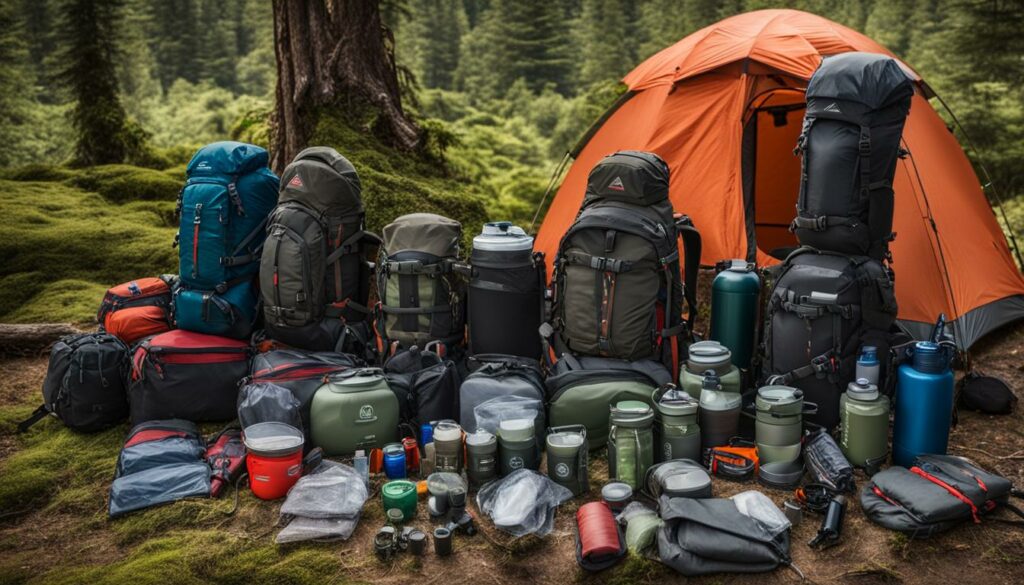
The Importance of Preparedness and Training
When it comes to outdoor survival, being prepared is absolutely crucial. Emergency preparedness and survival training can make all the difference in a challenging wilderness situation. It’s not just about having the right gear and equipment, but also about developing the right mindset and acquiring the necessary skills to handle unexpected situations.
Survival training provides you with the knowledge and techniques to navigate, find food and water, build shelter, and signal for help. It teaches you how to stay calm and make rational decisions in high-pressure situations. By undergoing survival training, you’ll gain the confidence and ability to survive and thrive in the wilderness.
Furthermore, understanding wilderness safety is essential for avoiding and minimizing risks. It involves learning about potential dangers, such as wild animals, hazardous terrains, and extreme weather conditions. By being aware of these risks and taking appropriate safety precautions, you can significantly reduce the chances of accidents and emergencies.
Key Points:
- Emergency preparedness and survival training are crucial for outdoor survival.
- Survival training provides the knowledge and skills needed to navigate, find resources, and signal for help.
- Developing a survival mindset helps you stay calm and make rational decisions in challenging situations.
- Understanding wilderness safety helps you avoid potential risks and minimize accidents.
Remember, being well-prepared and trained can greatly increase your chances of survival in the wilderness. Take the time to educate yourself, practice essential skills, and always prioritize your safety. By adopting a proactive approach and equipping yourself with the necessary knowledge and training, you’ll be ready to conquer any outdoor adventure and thrive in the great outdoors.

Recommended Survival Books for Further Learning
For outdoor enthusiasts seeking to expand their knowledge and skills in wilderness survival, investing in the right survival books is invaluable. These books provide a wealth of information, practical tips, and expert guidance that can enhance your outdoor skills and keep you prepared for any challenge. Here are five highly recommended survival books that cover a wide range of topics relevant to outdoor survival.
“The Ultimate Survival Manual” by Rich Johnson
This comprehensive survival guide offers step-by-step instructions for handling various outdoor scenarios. From building shelters and finding food to navigating in the wilderness, this book covers it all. It also provides valuable tips for surviving natural disasters and unexpected emergencies, making it an essential resource for anyone looking to master outdoor survival skills.
- “Bushcraft 101: A Field Guide to the Art of Wilderness Survival” by Dave Canterbury
- “SAS Survival Handbook” by John ‘Lofty’ Wiseman
- “Wilderness Medicine: Beyond First Aid” by William W. Forgey, M.D.
- “The Forager’s Harvest: A Guide to Identifying, Harvesting, and Preparing Edible Wild Plants” by Samuel Thayer
Whether you’re a beginner or an experienced outdoorsman, these survival books offer invaluable insights and knowledge that can help you thrive in the wilderness. They cover a range of topics, from basic survival skills to advanced techniques, ensuring you have the resources necessary to handle any outdoor situation. So, grab a copy of these books and continue enhancing your outdoor survival abilities for a safer and more enjoyable wilderness experience.
| Book Title | Author |
|---|---|
| The Ultimate Survival Manual | Rich Johnson |
| Bushcraft 101: A Field Guide to the Art of Wilderness Survival | Dave Canterbury |
| SAS Survival Handbook | John ‘Lofty’ Wiseman |
| Wilderness Medicine: Beyond First Aid | William W. Forgey, M.D. |
| The Forager’s Harvest: A Guide to Identifying, Harvesting, and Preparing Edible Wild Plants | Samuel Thayer |
Conclusion
Mastering outdoor survival skills is essential for anyone venturing into the wilderness. By equipping yourself with the knowledge and techniques covered in this comprehensive guide, you can confidently face the challenges that the great outdoors may present. From fire-making and shelter-building to water purification and navigation, these survival skills are the building blocks of your preparedness.
Remember, survival is not just about the physical aspects but also mental preparedness. Developing a survival mindset and understanding the importance of emergency preparedness are essential for your safety. Continuously learning and practicing these skills will ensure you are well-equipped to handle any situation that may arise.
The wilderness can be both beautiful and unforgiving, but with the right skills and mindset, you can navigate its challenges. Stay informed, stay prepared, and above all, stay safe while enjoying the wonders of outdoor survival.
How Can I Apply the Survival Tips and Techniques from Your Guide to Outdoor Exploration in America’s Wilderness?
Discover the ultimate nature exploration in america’s wild heart with our guide to outdoor exploration. Learn essential survival tips and techniques for navigating the wilderness, finding food and water sources, and staying safe in the untamed beauty of America’s natural landscapes. Embrace the adventure and thrive in the great outdoors.
FAQ
Are these survival skills suitable for beginners?
Yes, this guide covers essential skills for both beginners and experienced adventurers.
Where can I find reliable and practical survival advice?
This comprehensive guide provides expert advice and tips for outdoor survival.
What are some of the best survival books available?
Here are five highly recommended survival books written by reputable authors.
How do I start a fire in the wilderness?
This guide provides step-by-step instructions on fire-making techniques and fire safety measures.
What skills do I need to build a shelter in the wilderness?
This section focuses on the skills and techniques required to construct a shelter using natural materials.
How do I obtain and purify water in the wilderness?
This section covers various methods of obtaining and purifying water, ensuring a safe source of drinking water.
What tools do I need for wilderness navigation?
Carrying reliable navigation tools such as a map and compass is crucial for navigating the wilderness.
How can I signal for help in the wilderness?
This section explores different signaling techniques and devices that can be used in emergency situations.
What additional skills can improve my chances of survival?
Skills such as hunting, foraging, and food gathering can further enhance your wilderness survival abilities.
What equipment should I have for outdoor survival?
This section discusses the must-have gear and tools for wilderness survival, ensuring you are well-prepared.
How can I be mentally and physically prepared for outdoor survival?
This section emphasizes the importance of emergency preparedness, training, and adopting a survival mindset.
Are there recommended survival books for further learning?
This section provides recommendations for additional survival books to deepen your knowledge and skills.



